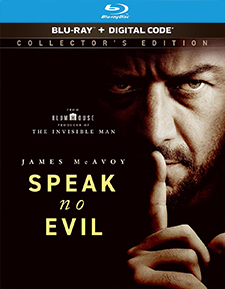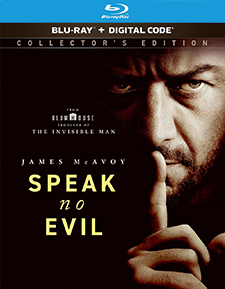Speak No Evil (2024) (Blu-ray Review)

Director
James WatkinsRelease Date(s)
2024 (November 19, 2024)Studio(s)
Blumhouse Productions (Universal Pictures Home Entertainment)- Film/Program Grade: A
- Video Grade: A
- Audio Grade: A
- Extras Grade: B
Review
Sometimes the best horror is the kind that creeps up on you in gradual stages, indicating something quite wrong is imminent. This is the case with Speak No Evil, a film that begins in beautiful, sunny Italy and winds up in a desperate fight for survival.
Americans Ben Dalton (Scoot McNairy, Once Upon a Time… in Hollywood), wife Louise (Mackenzie Davis, The Martian), and their 11-year-old daughter, Agnes (Alix West Lefler, The King Tide) have relocated to London for a job that didn’t pan out for Ben. Needing a distraction from the parents’ stress and their child’s chronic anxiety, which only her stuffed bunny can relieve, the Daltons take a vacation to Italy. Things go smoothly and take an upbeat swing when they meet gregarious English couple Paddy (James McAvoy, The Last King of Scotland) and his wife Ciara (Aisling Franciosi, The Last Voyage of the Demeter) and their young son, Ant (Dan Hough, TV’s Hollyoaks), whose shortened tongue leaves him unable to speak. The two families strike up a friendship and the kids get along, so the meeting adds unexpected fun to the Daltons’ getaway. When it’s time to part, Paddy invites the Daltons for a weekend at their home in the English countryside.
Thinking a stay with these pleasant people in a bucolic setting will be a good antidote to renewed stress over Ben’s future and nagging marital problems, the Daltons accept the invitation, drive out to the remote house, and are greeted warmly by Paddy and Ciara. Once Agnes and Ant have been sent to bed, the Daltons relax and chat pleasantly over drinks with their hosts. But Ben and Louise notice certain off-putting eccentricities of Paddy’s. To be respectful guests, they say nothing.
Paddy’s quirks become increasingly evident and upsetting. He comes down hard and rough on Ant for a minor infraction, challenges Ben’s masculinity, forces Louise, a vegetarian, to taste a piece of meat, invites the Daltons to dinner at a restaurant and has Ben pay the tab, and leaves the children with an unknown babysitter.
At many points when they should speak up, the Daltons are silent, observing rules of etiquette that demand you don’t criticize your hosts. A few times, Louise glances at Ben, hoping he’ll speak up, but he fails to protest, emboldening Paddy to further ill behavior. Meanwhile, Ant is desperate to communicate with Agnes, who doesn’t understand him until he takes her to a locked room and reveals its secrets. At this point, the mood shifts into full horror mode as Ben and family try to retain their cool while making an excuse to leave. The last 45 minutes of the film are intense and contrast dramatically with the earlier scenes of two nice families getting to know each other in a picture-postcard setting.
Writer/Director James Watkins has crafted an intelligent thriller with uniformly first-rate performances. It’s unusual for a horror film to have its central characters developed as real people rather than just screaming, terrified victims. His leisurely pace allows us to get to know the main characters and shows us in stages how Paddy reveals himself to be far more than a happy-go-lucky jokester. The dialogue in the first part of the film provides insight into the relationship between Ben and Louise, shaky before they meet Paddy but strained to the limit as time passes. The film is rich in subtext. Though the story becomes one of survival against perilous odds, it touches on themes of protecting one’s family, dealing with disturbing behavior in others, philosophies of parenting, pushing boundaries, and psychological abuse. Watkins paces the film beautifully, so that the groundwork is laid well before tension escalates to real danger.
McAvoy has a field day as Paddy. Whether teasing Ben and Louise with straight-faced fabrications and then laughing at their gullibility, questioning Louise’s vegetarianism, or giving Agnes a ride on his motorcycle without benefit of helmets, his Paddy exudes such confidence and self-assurance that he disarms any protest. He’s a charmer but also a manipulator. His intense gaze conveys a combination of defiance and power. His unpredictable behavior keeps Ben and Louise off balance.
Mackenzie Davis is very convincing as a protective mother coping with a husband who has lost his self-confidence and a daughter ravaged by anxiety attacks. Davis gets to show a range of emotions from polite acquiescence, to mild annoyance, to anger, to dread fear. Her performance elevates the film tremendously, and we can easily empathize with her character’s concern for her family and the extent to which she goes to protect them.
Speak No Evil is based on the original Danish film of the same name made two years earlier and directed by Christian Tafdrup, who based the story on his experience on holiday in Tuscany with his wife. They befriended a Dutch couple and were invited to visit them in the Netherlands. He eventually declined, but was inspired to imagine how such an invitation, if accepted, could turn into a nightmare.
Speak No Evil was captured digitally by cinematographers Tim Maurice-Jones and Mark Moriarty with Arri Alexa 35 cameras with Panavision C-Series, Atlas Orion, and Canon K35 lenses, and presented in the aspect ratio of 2.39:1. Contrast and clarity on the Blu-ray from Universal Pictures are excellent, with such details as the Italian countryside, the decor in Paddy’s English country home, the guest room that Ben and Louise stay in, facial whiskers on James McAvoy, stubble on Scoot McNairy, items in Paddy’s “trophy room,” and a gloomy, rain-soaked London street well delineated. Night scenes increase suspense, with shadows creating blind spots and magnifying the possibility of danger. Particularly beautiful are the high-angle shots of the Italian countryside. There are no perceptible imperfections in the Blu-ray print.
Audio options include English 7.1 Dolby TrueHD, Spanish and French 7.1 Dolby Digital Plus, and English DVS (Descriptive Video Service). Subtitles are offered in English SDH, Spanish, and French. Dialogue is clear and distinct. Ant is unable to speak but can grunt and yell to show his frustration and anger.
The score by Danny Benz and Saunder Jurriaans is subtle and avoids loud chords that shock. The music nicely supplements the growing feeling of dread that director Watkins creates. Sound effects include car engines, a blazing fire, sounds of body pummeling, locks being opened, and people splashing in a nearby river.
The Collector’s Edition from Universal Pictures and Blumhouse Pictures includes a Digital Code on a paper insert in the package. The following extras are included:
- Audio Commentary with James Watkins
- Nuclear Families (8:53)
- A Horrifying Crescendo (5:21)
- The Farmhouse of Horrors (4:00)
Audio Commentary – Writer/Director James Watkins refers to the style of Speak No Evil as “primitive minimalism.” The early scenes, set in Italy, were filmed in Croatia. Paddy and his wife live an “unshackled life,” which differs from the more controlled life of Ben and Louise. By setting the film in the UK, Watkins was able to write about characters he knows. The entire film was shot on location. Paddy is flamboyant, whereas Ben is laid back. With a winning personality, Paddy conveys an old country-style of living. At his home in the remote countryside, he’s in total control. The production design contains several disturbing images in paintings, tiles, and other objects. Watkins intentionally avoided the jump scares often used in traditional horror films. He speaks about the audition process for the role of Ant. Young Dan Hough was perfect and was immediately cast. In the last act of the film, Ben and Louise are “fumbling” to survive; they don’t automatically develop military skills, but improvise their defenses. Making them adept with weapons would strain credibility. Watkins says, “Making movies for audiences doesn’t mean making stupid movies.” He notes that making a film involves staging reality and then photographing it.
Nuclear Families – Actors James McAvoy, Mackenzie Davis and Scoot McNairy and writer/director James Watkins discuss the notion of family as interpreted by characters in Speak No Evil. Paddy loves to “push people’s buttons” and is an “overbearing, confident force of nature.”
A Horrifying Crescendo – The film contains cringe-worthy moments as the characters go down a “dark corridor.” An unspoken social contract compels the family to put itself in danger. Characters push each other’s boundaries. The film’s metaphorical horror becomes real horror.
The Farmhouse of Horrors – Paddy and his wife seem wholesome, but they have a dark side. The interior of Paddy’s house is surrounded by walls on four sides, suggesting not only protection but imprisonment. The low ceilings give the interiors a claustrophobic feel. The secret trophy room, neatly organized is creepy and indicative of previous horrors committed in the house.
Speak No Evil doesn’t rely on slashers, monsters, supernatural entities, or gross images to weave its tale of horror. Paddy, like Norman Bates, is a pleasant fellow who appears normal, yet beneath the facade lurks a malevolent, lethal creature. The film deals not with fantasy horror but with realistic horror that emerges from a warped sensibility and demented behaviors and drives, grounding Speak No Evil in what’s possible and making it all the more powerful.
- Dennis Seuling

